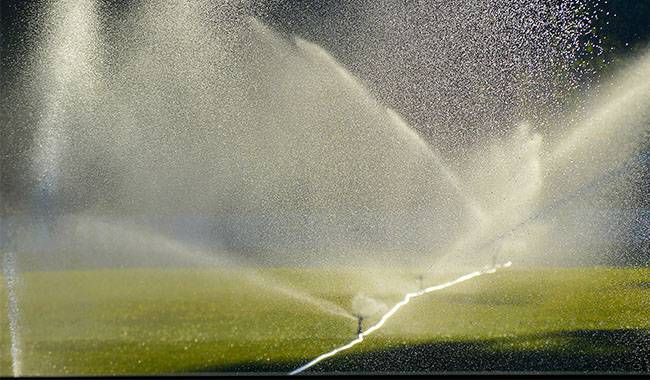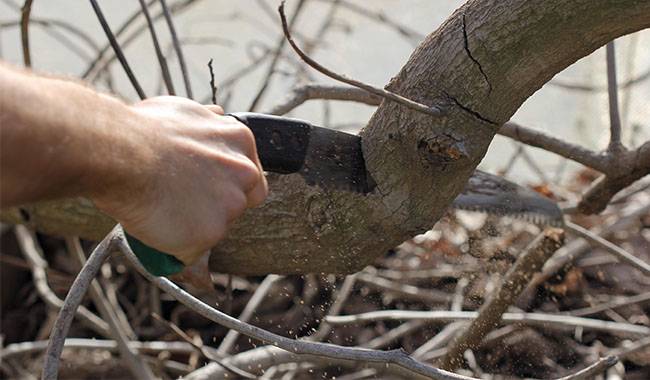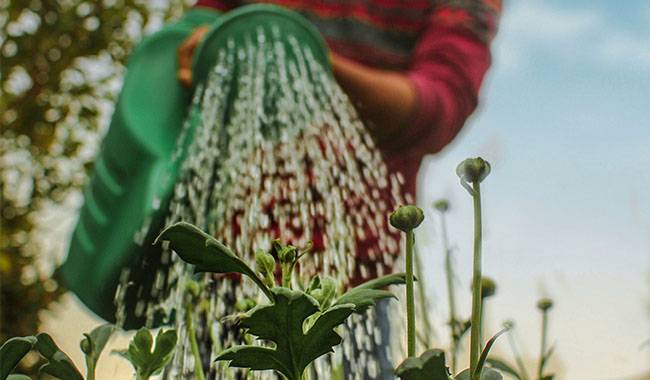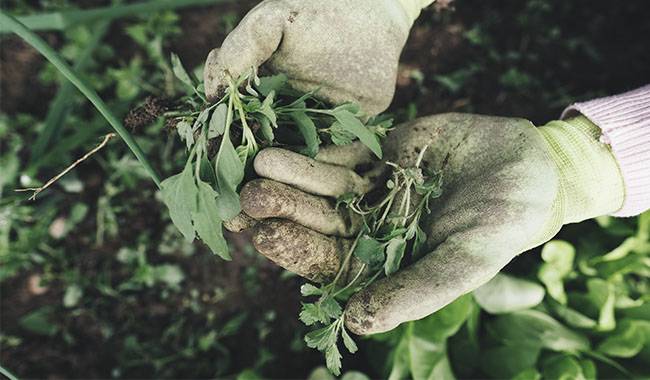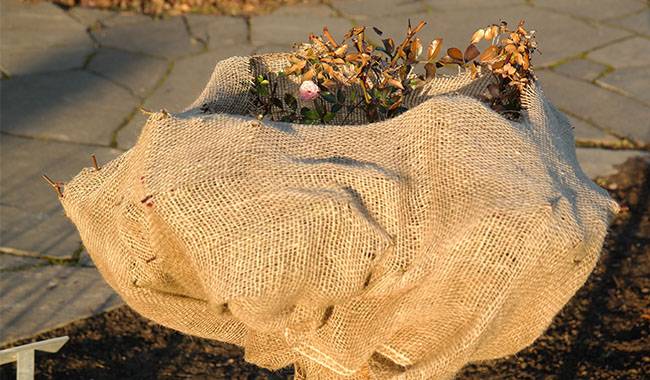
The cold of winter is here and new work awaits plant lovers in the countryside. Every year, traditional vegetable crops take up fewer and fewer beds and more and more plants from countries with different (warm) climates appear.
These can be hybrids of well-adapted flowering plants, exotic shrubs, interesting trees, and vines that can adapt well to the new climate. But they still need the environmental conditions to which they were accustomed in their former homeland.
Experienced gardeners are ready for the winter cold, but for beginners, there are many questions: when to mulch, what plants to mulch, how to mulch properly, what to mulch, and other equally important questions.
The answers to these questions about mulching plants we will try to find today.
WHY DO PLANTS NEED TO BE MULCHED FOR THE WINTER?
Covering plants for the winter is necessary:
- To create a warm microclimate below 5-14°F (-15 to -10°C) for each plant during the long frost period
- To improve the rooting of late and weak rooted plants
- To prevent freezing of surface roots and young shoots, when roots of perennial plants are subjected to frost and poor regeneration when frosts above 14°F (-10°C) persist for more than 5-6 days
- Damage to the trunk from frost – severe frosts following winter thaw cause bark cracking, damage to the lower cortex of the wood, gradual disease of the tree, damage and death by pests.
- Protection from sunburn; mulching takes place in the latter part of winter when the sun is particularly active; snow reflects the sun’s rays, increasing the ‘burning’ effect on the tree (conifers are particularly affected)
- For winter ‘droughts’ (strong winds in snowless winters); strong dry winds dry out the needles and cause conifers to die
- For rodent protection.
WINTER PREPARATION
Mulching plants for the winter and spring is the only job that will add to your tears in a hurry. You should start preparing for winter as early as July or August and do so in a thorough manner.
Firstly, check from a reliable source what kinds of plants should be mulched and what types of mulching are recommended for them. Secondly, it is generally accepted that all the plants to be mulched do not need to be fertilized with nitrogen in the latter part of the summer.
If you need to feed (roots, foliage), you should use a phosphate and potassium fertilizer. You can feed ash or ash solutions. Nitrogen causes rapid growth of shoots that do not have time to mature at the start of the cold and usually wilt in winter.
For the plants to survive the winter cold, the soil beneath them must be kept moist. You should therefore water your plants heavily before autumn moves into winter.
Make sure that conifers are watered intensively before winter. Until late autumn, or even as late as the start of winter, they are actively evaporating water and may simply die from ‘drying out.
In addition, hygienic autumn pruning should be carried out. Remove branches that are dry, crooked, visibly sick, and sloppily reaching out to the sides. Another task is to clear dried stems, leaves, and other debris from flower beds and tidy up the soil under trees and shrubs.
WHEN TO START SHELTERING?
In southern regions (especially those with little snow) shelters are often made to preserve the snow. Only representatives of subtropical and tropical regions need warm coverings, and these regions cannot tolerate even a slight cold spell.
But such gentiles were more often kept in winter gardens, grown in greenhouses over the winter, only to be taken out and put into open gardens in the summer.
In medium-sized areas, plants were covered for the winter from the end of October onwards. With long warm autumn, the mulching is shifted to November and, for some crops, to December.
They are mainly designed to protect against prolonged frosts, sunburn, and dry winds.
In northern areas, the presence of a permanent cold front below 5-14°F (-15 to -10°C) is more practical as a guide in order to cover in time.
It is not possible to mulch until cold weather arrives (especially warm), but it is also possible to delay mulching (when winter arrives with frost – which is also bad).
Removal of mulch depending on the area, but not earlier than March-April or when the temperature rises steadily above freezing. The mulch is gradually removed. Warm to cold weather, especially back frosts, can damage heat-loving crops.
Also, if the opening is delayed, excessive warm moist air will cause plants to germinate and die. Sunburn mulch should be removed once the snow has melted.
BASIC RULES FOR WINTER MULCHING PLANTS
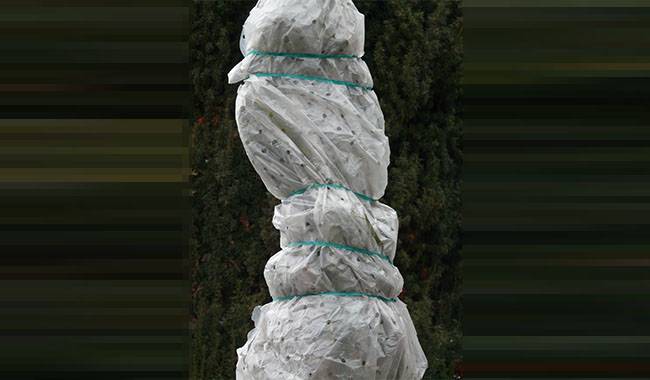
Any type of mulch should allow the plant access to air. Mulching should be done in such a way as to exclude the accumulation of moisture in the root zone. Plants will simply begin to wilt, mildew, and die.
When installing bulky shelters, branches should not come into contact with wooden walls, netting, and shelter materials. Freezing can lead to disease and the death of the frozen parts of the plant.
Cover plants gradually to accustom them to the lack and absence of light. Decommissioned plants should be completely mulched (dormant).
The main methods of winter mulching include weeding, mulching, air-drying the mulch with artificial material, and various other devices.
Mowing
This is the most common and acceptable method of protecting the root system in areas where cold and frost suddenly change the warm weather. Mowing young plants, shrubs and perennial flowers ensures a constant temperature in the root neck area and helps to keep vigorous shoots in the ground part of the plant and roots, located near the soil surface.
Start weeding plants when the soil is slightly frosty after the onset of cold weather. If you mound up during warmer periods, even in wet soil, the bark at the base of the plants may begin to harden, which will lead to the death of the root necks and shoots.
Mound the plants up with soil and rake into a mound around the base of the culture so as not to expose the roots. The mound should be 4-16inch (10-40cm) high, depending on the height of the stump or perennial branches of the nursery.
If there is not enough soil for mounding, garden soil can be used, but it is important that the roots are not exposed and that a mound is collected around the plants.
As warm weather approaches, the mound gradually opens up, keeping it as sloping as possible so that spring moisture will run from the trunk to the edge of the canopy and not stagnate at the base of the plant.
Tea hybrid roses, Korean chrysanthemums, Eragonia, and other heat-loving plants should be no more than 8-12inch (20-30cm) high to avoid winter frost.
Mulching
This type of mulching is more easily carried out on vegetables and flowering plants that are not hardy and have a shallow root system. The mulch is used without touching the soil around the plants.
It is mulched with dry material, using dried leaves from healthy autumn fruit, garden, and forest plants (birch, maple, chestnut). It is not advisable to cover the soil under the plants with oak and walnut leaves.
As a ground cover, you can also use top peat, which can be sawdust (decomposed, semi-decomposed), humus, mature compost, fine wood chips, shredded bark.
Before mulching, make a small mound of sand or soil no higher than 2.8-4inch (7-10cm) at the base of the trunk of young trees and spread mulch around it no more than 16inch (40cm) high.
Do not cover the trunk directly with mulch – it may start to harden.
Remember! Plants often die not from frost, but from incorrect mulching.
Mulch is a very good material to reduce heat loss from the soil and to protect the roots of the garden and flowering plants. However, there is a BUT.
In autumn, when there is a lot of rain and no snow, leaves, peat, and sawdust can get wet and become accomplices in the decay process (especially for plants with ground rosettes) or, in the subsequent frost, freeze into ice, which will not protect the roots from frost.
In addition, peat, sawdust, and shavings acidify the soil during the decomposition process, so not every plant can be mulched with them. Mulch, like snow, is a very handy material for keeping the ground warm in areas with early snow.
Using dried leaves or humus, daisies, carnations, primroses, violets, hyacinths, daffodils, anemones, garden daisies, aloes, delphiniums, garden peonies, geraniums, and other plant varieties as mulch will protect against frost.
MULCHING WITH NATURAL MATERIALS
Perennials and ornamental low shrubs can be mulched with bushes (branches of conifers and bushes), deadwood (stalks of sunflowers, maize), ferns, or brambles.
In some areas, straw and reed mats and other natural materials are used successfully for insulation.
Mulch
Mulch is a good mulching material, but only fully sound materials should be used. They do not accumulate moisture (like leaves), are breathable, and retain snow, which makes them excellent insulators for shrubs and other tall, spreading plants. The stinging needles repel rodents.
Nettles are used to binding the holes of young trees to prevent predation by hares and to mulch young conifer seedlings to prevent sunburn in winter and early spring.
When using rockweed for mulching, consideration should be given to the fact that it loses some of its needles in winter, and that these needles begin to decompose and acidify the soil as they break upon the ground. These mulches should only be used for crops that resist soil acidification.
Weeds
Weeds do not protect plants from frost but do not hinder air exchange, do not rot in wet weather, hold snow well and create a positive microclimate under a blanket of snow. It is easy to use in areas with snowy winters.
Ferns
The sturdy branches of ferns can easily make a shelter on stunted – up to 20-30inch (0.5-0.7m) tall – thermophilic shrubs and flowering perennials.
It combines well the properties of ferns and dried foliage but additionally needs to be covered with waterproof fiber or film.
Straw
Straw laid in a loose layer to a height of 2.8-4inch (7-10cm) is a good, inexpensive mulch when sowing and planting vegetables in winter. It is practical to use a straw to insulate flowering perennials.
Covered with twigs, sunflower stalks, and maize, it retains snow blown away by the wind and keeps enough heat in.
But this mulching material also has its drawbacks. Like leaves, straw accumulates moisture (becomes wet). In warm weather, a humid microclimate can form under a layer of straw, which causes it to become moldy and infected by the mold of the cover crop.
Mice and other small rodents, pests, and plant pathogens (fungi, micro-organisms, viruses) that like to nest in the straw winter.
Under the straw, the accumulated moisture slows down the thawing of the soil, which requires an early harvest of the mulch to speed up the warming of the upper layers of the soil.
If there is an abundance of straw and no other mulching material, it is best to use it as a straw mat. They do not allow water to pass through, are light in weight, and do not weigh down the plants. Underneath them, the plants stay dry and well warmed in frost.
Deadwood
When covering tall ornamental grasses for the winter, sunflower and corn mounds can be used as a substrate. When the first frost arrives and the flowering period is over, you can usually mulch them for the winter.
On a dry, sunny day (not foggy or wet), tie the dried stems and wilted leaves of perennials into one or more loose bundles or bunches.
Each can be tied in 2-3 places (large horsetail, ornamental reeds, Japanese sedge, fescue) so that the winter wind does not blow the crop away. The leaves of the plants themselves provide extra protection. Remove them in the spring.
Tie them with soft twine or other material (not a fishing line). Poke a pile of deadwood around these bushes and also tie them in 2-3 places. It becomes a fence and acts as an extra fence to hold the snow and provide extra protection from frost and wind.
ARTIFICIAL AIR PLANT SHELTERS
In addition to the natural (modified) mulching materials almost universally used by summer residents to insulate gardens and garden plants as well as lawns, used by gardeners to insulate gardens and quilted plants as well as lawns, the market offers a large selection of artificial mulching materials: agro fiber, spunbond, agro fiber, coarse linen, jute, different types of film, etc.
The main and most acceptable methods of using artificial materials for winter shelters are
- free swaddling.
- Using ready-made covers.
- Hiding on the ground.
- dry air shelter.
Free swaddling blankets and ready-made covers are used for winter shelter for young seedlings of conifers and fruit crops, heat-loving shrubs.
This is the main cover material used to build shelters on wooden foundations in the form of halachic, benches, triangles (tripods), and other types of construction.
Free swaddling
From February to April there is a wave of temperature fluctuations, snowfall, and then sunny days which can threaten conifers with sunburn. Young trees and shrub conifers with a height of 1.0-1.5 meters are most vulnerable during this period.
Under the influence of the sun, the needles are awakened. The process of photosynthesis requires water, but the roots of the plant remain dormant. The above-ground parts do not absorb water, so the conifers become dehydrated.
In the presence of solar radiation, physiological desiccation begins to set in. A physiological heat burn develops, leading to the fragmented and sometimes complete death of young seedlings.
The best way to protect a tree from burning is to wrap it in any breathable non-woven fiber that is strong enough (so that the thin fabric is not torn by the wind). The bottom edge of the fiber is secured to the soil.
You can simply cover it with snow. Wrap the plant from the bottom up, overlapping the edges of the fabric slightly, all the way to the top.
The swaddling is light (not tight) and it is held in place with string, twine, during the swaddling process. in April, when the plant’s roots have started to work (the soil thaws to the bayonet of the spade), the wrapping is removed and the water reaches the needles.
The sun’s rays no longer fear the plants. swaddling in February should be checked systematically, especially after a snowfall, to shake off excess snow from the wrapped trees.
Instead of swaddling, you can use shade nets with different densities (50-75%). They are particularly effective in southern areas.
Tip. Experienced gardeners pour a bucket of boiling or very hot water around the trunk of the tree (not the trunk) in April in order to quickly wake up the roots of conifers from dormancy (but just not to scald the roots).
Conifers planted in the southeast, southwest, or south, against white buildings, walls, fences, should be protected from sunburn.
Repeat swaddling until 3 years of age, regardless of conifer type, and keep at a later age for thuja, cypress, juniper, Canadian spruce species, and other observation-based plants.
Use ready-made covers
You can use ready-made covers and cones (available in shops), or sew your own. It is more practical to use covers to protect conifers with wide canopies and tree peonies from sunburn or wind, and cones to protect young trees.
Mulch, cones, and other shade are thrown on top of the plants, laid over the canopy, and held in place by sticks and ropes when they do not reach the ground. From above, the plant is enclosed, from below it is freely ventilated.
This method is easier to use in low snow areas where sub-zero temperatures are relatively low. The plant is shaded in bright sunlight and removed on cloudy days at established positive temperatures.
Shelter
Many climbers, vines, and ornamental shrubs, which flower on the shoots of the previous year, need protection from the winter cold. They are protected by taking shelter.
Prepare a wooden fence or a special wire support bed underneath the plants to protect them from moisture (prevent rot, mildew). Vines, vines, and bines that have been removed from their supports are placed on the terrace.
If the branches are stubborn, bend them gently and secure them with string to stakes driven into the soil or to the terrace. Duck filling should be done before frost sets in.
Otherwise, brittle timber breaks easily when bent after a frost. In areas with little snow in winter, they are mulched with brushwood, Mulch, to reduce snow.
On top of Mulch, brushwood, any cut branches, can be covered with any breathable agricultural canvas (an air layer is a must).
Protect Willowherb, Hydrangea, Climbing Rose, European Grape, 1 and 2 pruning groups of Clematis, Brown Honeysuckle, Rhododendron, Lemongrass, Chinese Wisteria, Sphagnum, Forsythia, Rhododendron from winter colds.
As the thaw approaches, start opening the plants. Gradually carry on opening to protect the plants from sunburn.
Air-drying cover
The most reliable winter protection in colder regions is a variety of structures in the form of rigid frames and covering materials. Frames can take different forms – cones, cubes, ‘stools’, round or triangular huts.
It is best to frame with warm materials (planks, plywood, wooden poles, plastic, etc.). Steel will only make it colder.
The frame should be able to withstand snow layers of up to 20-24inch (50-60cm) and gusts of wind. The covering material is made up of 2 layers – warming and moisture barrier.
The warming or insulation material, depending on the climatic conditions of the area, can be Mulch, dry healthy leaves, mats made of straw and reeds, old newspapers, linen, modern non-woven materials which should be breathable.
The moisture barrier can be made of aluminum foil or ruby or other moisture-resistant materials. Before installing the frame, remove all fallen leaves and other debris remnants from underneath the plants. The soil should be moderately dry and the plants free of foliage.
Allow the plants to come to a complete rest. To prevent them from drying out, vents should be left open, which can be opened during the thaw, to remove excess moisture accumulated during the cold period, and to allow fresh air in.
The main condition for an air-dried shelter is the presence of an air layer between the insulation and the moisture barrier. It will create the necessary constant temperature. Shelter work can be complex. Therefore, the “house” can be combined with rising and mulching.
The following types of garden and park plants are needed during the winter period of forced air-dry protection: roses, cypresses, boxwoods, junipers, rhododendrons, alpines, thuja, young conifers, many perennial flowers, southern shrubs, and others.
Dear readers
It is impossible to cover in one article all the types and methods of plants that are protected from winter weather conditions, nor is it possible to describe all the materials used to ensure that our southern favorites and exotics are wintered comfortably, nor is it possible to list all the types of plants that require mulch.
No doubt every large estate owner has his or her own proven methods of protecting plants from frost, spring temperature fluctuations, and sunburn. Share your knowledge and experience in the comments. We would be very grateful.




